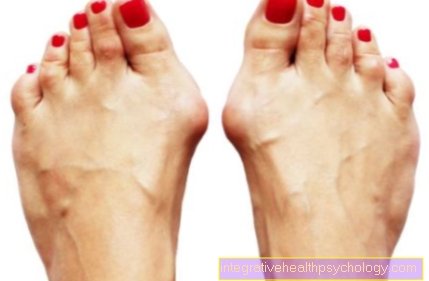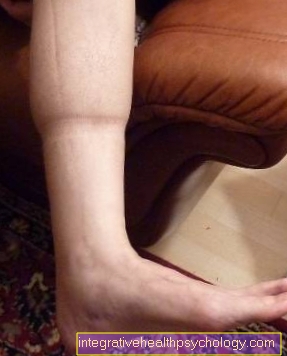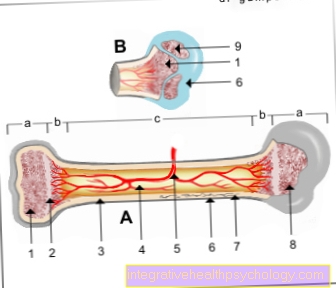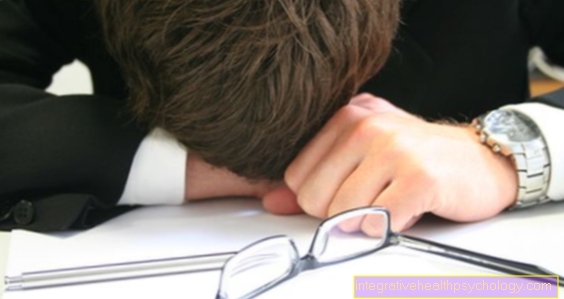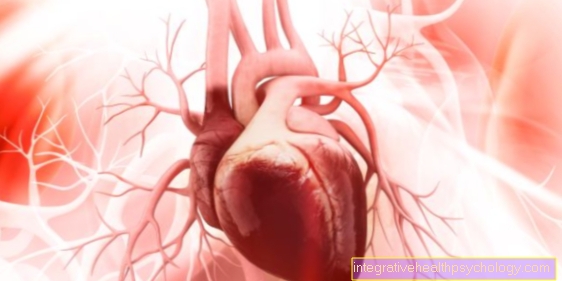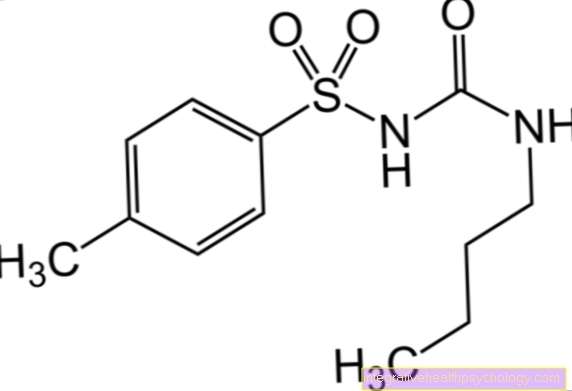Burnout syndrome
Synonyms
- Burnout
- exhaustion
- Burn out / being burned out
- State of total exhaustion
- Run away

definition
The name 'Burnout" comes from the English "to burn out": "burn out". This is understood to mean a state emotional and physical exhaustion which is accompanied by a massive lack of drive and performance.
Burnout particularly affects people in social professions, such as nurses, doctors and teachers. These are often people who devote themselves to their profession and often receive little recognition.
Also at risk of burnout are people who primarily define themselves through their job and strenuous work and who put everything else such as social contacts and hobbies in the background. If these people then experience frustrations at work, they ultimately collapse because they lack the right balance.
Often the burnout syndrome is the final stage of a previously longer lasting one Overwork or overwork. The path to burn out can sometimes take a few years. Typically, a burnout syndrome arises from a combination of a sense of duty, motivation, ambition and perfectionism paired with persistent stress, strong pressure to perform and / or excessive demands.
Are the triggers for burnout
- too high performance demands on oneself, as well as too high a commitment
- the willingness to work non-stop
- putting aside personal needs and social contacts
- renouncing rest and relaxation
Burnout usually develops gradually and often lasts for several months to years. Ultimately, however, it always ends in a complete physical and mental breakdown, where even the simplest tasks no longer seem feasible.
In medicine, the burnout syndrome is not recognized as a disease in its own right, but is only classified in the International Classification of Diseases (ICD) -10 key to "Problems related to difficulties in coping with life".
frequency

According to representative studies, around 7% of all employees suffer from one Burn out symptoms. 20-30% of all workers are at risk.
In principle, burnout can affect anyone. People who are not working, such as schoolchildren, retirees or the unemployed, are also affected by the burnout syndrome. Nevertheless, in certain professional groups (e.g. teachers, managers, nurses, social workers, pastors, doctors) particularly high levels of sick leave with a corresponding diagnosis can be recorded. The decisive factor here is not the number of hours worked per week, but rather the pressure to perform, emotional stress, individual factors and the working conditions that ultimately lead to complete exhaustion.
There are no exact figures on annual new illnesses, as burnout syndrome is not a clearly defined disease, but a clinical picture with diverse and sometimes very different symptoms. Scientifically, the actual annual new cases are very difficult to record. What is certain, however, is that the number of new cases is increasing more and more each year and the burnout syndrome is now spreading to all occupational groups.
causes
A vicious circle of overwork and excessive demands over many years is believed to be the cause of burnout. During this chronic stress phase, the interaction on two levels causes burnout.
- The first level is characterized by external stress factors, i.e. long working hours, unfavorable working hours that neglect the individual biorhythm, stress / anger / conflicts with work colleagues, family members or the partner, a strong hierarchical structure at the workplace, high performance or time pressure, fear for the Workplace, little positive feedback, etc. Burnout can also be the result of bullying. Not everyone who works or lives under such external stress factors will inevitably develop burnout.
- In addition, there are internal personality factors on the second level, such as perfectionism, high ambition, unrealistic expectations of the job and oneself, the difficulty of saying “no”, the tendency to ignore one's own need for regeneration, distrust of the abilities of others and overestimation of one's own performance .
One can very well imagine burnout syndrome as the end point of a downward spiral. In the end there is complete collapse.
According to Johannes Siegrist, the causes of burnout syndrome lie in the imbalance between a person's requirements and resources. Therefore the medical sociologist developed a questionnaire to record professional gratification crises.
"Requirements" include statements such as: "I am constantly under time pressure." "I have a lot of responsibility." "I am often disturbed at work." "In recent years my task has become more and more demanding."
Examples of statements made by the resources are: "I am not treated with the necessary respect by my superiors." "If I have difficulties I do not get adequate support." "I am often treated unfairly." "My professional future is uncertain."
In addition to the imbalance between requirements and resources, there is often an exaggerated sense of obligation and insomnia.
The other model that tries to describe the causes of burnout is the requirement-control model of Karasek and Theorell. People who suffer from constant work stress and at the same time have limited room for maneuver to make decisions are more likely to suffer from burnout. Examples of this are supermarket vendors, assembly line workers, etc.
Using the two models, certain risk factors can be formulated that can favor burnout:
A lot of stress at work, a lack of positive feedback, the lack of boundaries between professional and private life, expectations that are too high and personal goals, excessive demands in the job, threatened job loss, low income, perfectionism, fear of rejection, criticism and failure, etc.
Symptoms
The symptoms of burnout affect both the psyche and the human body.
Burnout usually begins gradually with unspecific symptoms such as persistent tiredness and exhaustion. Often these symptoms are ignored and dismissed as normal performance kinks.
At this moment, it would make sense to hesitate and step back.
Instead, many of those affected are increasingly pushing their limits.
You begin to reduce social contacts and breaks in favor of work and also to work a lot of overtime.
In phase II of the development of burnout, those affected encounter more and more incomprehension and criticism from their families and friends, as these are now extremely neglected. Often, however, those affected do not see this as a warning, but much more as envy and resentment.
This in turn leads to an even stronger retreat and more falls in work. Those affected begin to see themselves more and more as lone fighters and to be successful even without the support of others.
Typical symptoms are that performance and concentration decrease more and more, those affected begin to make mistakes and become more irritable when dealing with customers and colleagues. Often those affected now look to others to blame for their own failures and isolate themselves even more. Finally, there are also physical symptoms such as back pain, neck pain and headache.
People begin to take pain medication or drink alcohol. However, this in turn leads to harmful substance use, sleep disorders and panic attacks.
In phase III of a burnout, there is ultimately surrender. Body and mind are already being used to their limits. Those affected notice increasing exhaustion, weakness and weakness.
The constant stress leads to increased cortisol levels, which in turn promote sleep disorders, increased sweating and an increased susceptibility to infections.
There are also gastrointestinal complaints. Abdominal pain, constipation and stomach ulcers are typical symptoms of burnout.
Often there are also cardiac arrhythmias, so-called palpitations (heart stumbling) and palpitations. The risk of vascular diseases, such as coronary artery disease, circulatory disorders and heart attacks increase.
There is chronic muscle tension, back pain and headaches. Nothing seems to bring more joy to those affected. You feel drained, tired and listless.
Those affected notice a loss of interest in everything that previously gave them pleasure. Brooding and a depressed mood become more and more evident. The burnout has now turned into a depression.
At this point in time, many burnout sufferers have only a few caregivers who represent a last stop for them. If those affected ultimately lose this person as well, many find themselves in a deep hole, where much seems hopeless and those affected feel a strong inner emptiness. Many try to fill this insensibility with excessive alcohol or the like, but have to realize that this also does not improve their situation. Out of this desperation, many burnout sufferers think of suicide for the first time.
At this point at the latest, a doctor, psychotherapist or counseling center should be consulted urgently.
Specific symptoms
Shortness of breath and burnout:
Shortness of breath or by the medic also as Dyspnea is a subjective feeling of being unable to breathe. This can have many causes. Examples of causes are e.g. Heart disease (Cardiac insufficiency, CHD, valve diseases); Lung disease (asthma, COPD, lung infection, Lung cancer) or psychological (Hyperventilation in fear).
Especially with burnout, breathlessness is often sudden Panic attacks and fears connected.
However, as many of those affected also have a very unhealthy lifestyle due to their work To smoke cigarettes, Alcohol, greasy and unhealthy food, as well as a lack of recovery, cardiovascular diseases or lung diseases (lung cancer) are not atypical.
A medical examination is recommended.
Diarrhea:
Having an unhealthy lifestyle constant stress, lack of relaxation and irregular eating can often lead to Indigestion With diarrhea, constipation and Stomach ulcer to lead.
High blood pressure:
As Blood pressure This is the name given to the pressure that the blood exerts on the walls of the blood vessels. The systolic blood pressure is normal 120mmHg and diastolic at 60-70mmHg.
Too much stress in the workplace can cause one permanently high blood pressure come, which at first often goes unnoticed, but has many side effects.
In 9 out of 10 people with high blood pressure there is no concrete causes, it is caused by idiopathic origin, so to speak; However, studies have shown that long-term overload at work or at home can lead to long-term high blood pressure. One speaks of an increased blood pressure when the systolic value is over 140mmHg lies and the diastolic over 80mmHg.
Consequences of increased blood pressure can Vascular changes be with circulatory disorders of all organs. This results e.g. Heart attack, stroke or Kidney failure. Burnout patients in particular are often affected by high blood pressure and its physical consequences due to their unhealthy lifestyle and the high level of stress at work.
Therapeutically, a reduction in stress at work and in everyday life, endurance sports and a healthy diet should be aimed for. Relaxation techniques such as autogenic training can be easily learned and helpful. If a change in lifestyle does not result in any success, the blood pressure should be adjusted with medication by the family doctor or cardiologist.
Cardiac arrhythmias:
A cardiac arrhythmia (also called arrhythmia) is a disorder of the normal heartbeat sequence that is caused by an excitation disorder or a conduction disorder. They can occur in people with healthy hearts as well as people with heart problems.
In healthy people, cardiac arrhythmias rarely have a disease value - everyone knows the feeling of a sudden palpitations or brief heart palpitations, which occur suddenly and usually go away on their own.
In cardiac patients, however, arrhythmias can be life-threatening and lead to diseases such as stroke, heart attack and heart failure.
Cardiac arrhythmias such as stumbling or racing heart are a typical early warning symptom, especially with burnout.
Sweat:
Persistent stress and a lack of recovery even at night lead to permanently increased stress hormone levels in the blood of those affected. This often leads to insomnia, heavy sweating (night sweats) and nightmares.
Also brooding thoughts about what still needs to be done or whether an early termination could threaten; trigger fears and nightmares in many of those affected, which in turn are accompanied by sweats and panic attacks.
Good treatment methods here would be relaxation methods, sleep hygiene and psychotherapy. The use of medication can also be helpful.
Panic attacks:
Temporary fears and worries cause many people to break out in a sweat and panic. However, these will subside as soon as the problem is resolved. Sometimes, however, fears can also become pathological and begin to dominate the lives of those affected.
Such pathological fears and panic attacks are often associated with depression. Panic attacks are sudden attacks of fear that appear out of the blue and are often associated with vegetative (i.e. physical) reactions such as racing heart, shortness of breath and sweating.
These fears can be targeted or diffuse (aimless) and in the course lead to fears of further panic attacks, a so-called fear of fear (phobophobia).
Due to the constant stress and the inability to “switch off”, many sufferers of burnout develop a panic attack in the course of the process.
Depression:
As already mentioned above, burnout - due to numerous factors such as frustration and social isolation - can always turn into depression. Burnout per se is only a physical and mental state of exhaustion, where the smallest things in everyday life seem increasingly difficult to do and those affected feel burned out and drained.
Many of those affected appear cynical, impulsively aggressive or even resolute, indifferent.
Depression, on the other hand, is rather characterized by a depressed mood, a loss of interest and a massive lack of drive. Furthermore, also through: sleep disorders, circles of thought, suicidal thoughts and physical symptoms (abdominal pain, palpitations, etc.). In the final stages of burnout, however, there is almost always depression.
The following article provides you with numerous differences between depression and burnout syndrome: Depression or Burnout - What do I have?
Speech disorder:
A permanent overload of the body ultimately leads to disturbances of concentration and cognition (thought and perception processes). This can ultimately manifest itself in a language disorder or word finding disorder. For example, it is difficult for those affected to formulate a reasonable sentence, the words they are looking for no longer come up or word syllables and letters are mixed up with each other.
Many of those affected have difficulty remembering things or foreign languages that used to be like their mother tongue.
Since language disorders can also be typical for incipient circulatory disorders in the brain and for a stroke, first-time language disorders should be clarified to be on the safe side.
Read more on the topic: Burnout symptoms
Stages of burnout syndrome
Burnout syndrome can be divided into 12 phases.
- At first, the urge to prove something to yourself and to others is very strong.Affected people tend to compete permanently with others (work colleagues).
- Due to an excessive willingness to perform, those affected place very high demands on themselves, they demand ever more utopian things from themselves. The personal commitment is constantly increasing, tasks cannot be passed on to other people.
- In this phase your own needs are pushed further and further into the background. Above all, basic needs such as eating, sleeping and leisure are becoming less and less important. Instead of looking for rest and regeneration, those affected throw themselves more and more into working life and the self-imposed task of proving themselves professionally and advancing.
- In this phase the first physical symptoms can already appear. However, less and less attention is paid to one's own body - warning signals from the body are ignored.
- Hobbies are perceived as annoying. Contact with friends and family is also reduced. Things that used to offer relaxation become a burden.
- The physical complaints increase. Anxiety, headache, fatigue occur. However, the symptoms continue to be ignored and nothing is done about it.
- Affected people begin to withdraw. An increasing isolation begins. Alcohol and medication are consumed more and more. Social contacts are reduced to a minimum.
- This phase is characterized by an inability to criticize: The environment begins to point out to those affected that they are isolated and the signs of burnout. This is mostly taken personally and seen as an attack.
- At this point, the person concerned loses all connection to himself. Warning signals from the body are no longer perceived. There are hardly any social contacts left. Life is becoming increasingly functional and mechanical: it is no longer about quality of life, but rather that life as such functions.
- At this stage, those affected often feel anxiety in addition to exhaustion and discouragement. To counteract this inner emptiness, they almost desperately try to find something to do or to cover up these feelings. Alcohol, sexuality and drugs play an increasingly important role.
- In this penultimate stage, other mental illnesses often occur. Signs of depression are becoming increasingly evident. Hopelessness, lack of interest and the feeling that there is no longer any future are intensified.
- In the last phase there is a total breakdown of body and soul. The risk of other (physical) diseases such as cardiovascular or gastrointestinal diseases increases. Many affected people have thoughts of suicide during this time.
also read: Burnout phases.
Prevention

In the case of burnout syndrome, it is difficult to explain a specific method of prevention because the disease is affected by the Personality of the person concerned depends and from external factors in his environment. For everyone, the causes can be of different origins and ultimately lead to that Feeling of being burned out.
Some tips that can be given to those affected are his personal goals realistic to put, targeted Relaxation exercises try to do sports in order to reduce stress enough sleep to find. A lot has to change professionally as well: The work structures have to be changed so that the Pressure to perform and workload reduced become. More autonomy at work needs to be guaranteed so that those affected can go home feeling positive. A good working atmosphere create with lots of light and little noise in the workplace. Keep the opportunity open to do further training. This creates a feeling of self-determination, which can have a preventive effect.
diagnosis
Since the Burnout syndrome can express differently, the diagnosis should only be made by a specialist. This has various methods available.
Maslach Burnout Inventory (= Admission) is a questionnaire about the frequency and strength of the three main symptoms of exhaustion, depersonalization and dissatisfaction with performance.
Copenhagen Burnout Inventory is another questionnaire that comprises 19 items, which are divided into three categories. The measure of the physical and mental experience of fatigue. The occupational stress and exhaustion. The dissatisfaction and the weakness that is made aware while working with the person concerned.
in the Tedium measure the same questions are asked as in the Maslach Burnout Inventory, but only the frequency is asked.
There is other various teststhat a specialist can work with, however, there is none imaging procedurein order to be able to prove burnout.
Burnout sick leave
Most sufferers with burnout go because of Trouble sleeping or digestion, Back pain or headache to the doctor.
Burnout is often overlooked. Doctors can only diagnose burnout through precise inquiries and a lot of experience.
If the Diagnosis of burnout But once it is established, depending on various factors, those affected can have a Sick leave up to 6 or 12 months receive. However, it is also important to use the sick leave not just for a short-term recovery, but also for one psychotherapy to start.
There should be possibilities of Stress relief can be found, and behavioral techniques are learned with which one can prevent further burnout. This is the only way to prevent a relapse at work.
Today, sick leave due to burnout or depression is one of the most common causes of incapacity for work.
therapy
There are no uniform treatment in burnout disease. Everyone concerned has individual problemsthat cannot be resolved by any standard therapy. That is important psychotherapy.
Here has the Behavior therapy presented as successful. The Conflict and stress management are practiced with a therapist and self-confidence is strengthened. Your own behavior is changed so that you no longer drive yourself into a state of complete overload. In addition, those affected must alone or with her help Revise life. You must have hers Check expectations and Give up unrealistic goals. The Work situation must also transform. Perhaps certain work can also be given to colleagues.
The physical fitness must go through healthy eating and way of life are strengthened.
Also the People in families and friends should be more involved in your own life. They serve as emotional support. Those affected have to regular rest breaks treat professionally and privately. So it can help to simply switch off the mobile phone at home.
People with severe burnout often suffer from it depressions. If these are very strong, a doctor should be consulted. The doctor can then prescribe medication to stabilize the patient's condition. Serve frequently Serotonin reuptake inhibitors (SSRI) for this purpose. Side effects can occur when taking the SSRIs. nausea, diarrhea, Loss of appetite, sleep disorders, Erectile dysfunction can occur.
burnout is a serious disease. If symptoms such as emotional fatigue, lack of drive, weakness, lack of interest and a feeling of constant failure occur or if the environment and personal personality seem unreal, a doctor should be consulted.
Burnout and relationship
Burnout is often a Ultimate test for many relationships.
Burnout is becoming more and more common more irritable, more cynical - also towards her partner.
You are no longer resilient and withdraw more and more. An everyday life for two is often no longer possible. Caresses or Leisure activities are increasingly placed in the background, so that the partners of those affected often experience the feeling of losing access to their loved one. Relatives often find it difficult to deal with new situation and her exhausted partner to deal with. If they offer advice, it is often ignored or dismissed. Relatives often reach their limits, which is ultimately in separation or divorce ends.
Even those affected find it difficult to cope with the new situation. It is increasingly difficult for them to meet the demands and wishes of their partners; to understand them and to accept their idiosyncrasies. People affected by burnout often react more sensitive than before to criticism and appeals
What could help couples in this situation is that open communication about worries and feelings. Relatives of those affected should show a lot of understanding and generosity. Of course, you shouldn't put your own needs in the background; But those affected by burnout need a lot of support and understanding, especially in this situation.
Also one Psychotherapy / couple therapy can prove helpful.
Burnout doesn't always mean the end of a relationship, however. Many couples manage to get through this difficult time together and notice how stable and resilient their partnership has become in retrospect. Burnout can always represent the chance for a long future together. It is only important that those affected recognize their illness, accept it and are willing to do something about it. The support of relatives plays a decisive and important role here.
course
At the Beginning a burnout illness always stands completely excessive sacrifice for the profession. During the Job more and more important wins, become other things less important. This means that those affected define themselves more and more through their job. Due to the amount of work, however, both the private life and the health of the patient suffer. Physical warning signs and lack of sleep are simply ignored.
Soon make up more mistakes noticeable. This in turn means that those affected invest even more energy and time in their work.
At some point it is Load limit reached: you can simply no longer. While those affected usually withdrew from family and friends at a much earlier point in time, now the Job increasingly neglected.
An inner void spreads and paves the way for other mental illnesses, such as a depression.
Ultimately, there is a total breakdown. At least now is professional help urgently needed!
An inpatient stay in the hospital is often unavoidable.
After appropriate therapy and with the support of friends and family, most people can easily find their way back to a normal and healthy life. Many take a break from their jobs and concentrate more on themselves and their needs.
forecast
The sooner you are diagnosed with burnout syndrome, the better the chances of a full recovery. For many is one lengthy therapy necessary to find the way back to a regular life. Nevertheless, this works well for most of those affected.
Nonetheless, burnout syndrome is a serious illness that should never be trivialized by those who are not affected. Instead, they should support those affected as much as possible.



